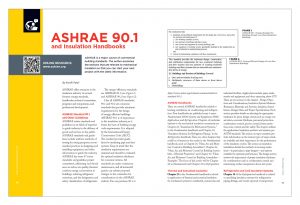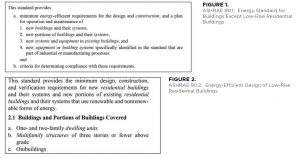ASHRAE 90.1 and Insulation Handbooks
ASHRAE is a major source of commercial building standards. The author examines the sections that are relevant to mechanical insulation so that you can start your next project with the latest information.
ASHRAE offers resources to the insulation industry via several formats: energy standards, handbooks, technical committees, programs and symposiums, and professional development.
ASHRAE Standard 90.1 and Other Guidelines
ASHRAE writes standards and guidelines in its fields of expertise to guide industry in the delivery of goods and services to the public. ASHRAE standards and guidelines include uniform methods of testing for rating purposes, recommended practices in designing and installing equipment, and other information to guide the industry. ASHRAE has some 87 active standards and guideline project committees, addressing such broad areas as indoor air quality, thermal comfort, energy conservation in buildings, reducing refrigerant emissions, and the designation and safety classification of refrigerants.
The energy-efficiency standards are ASHRAE 90.1 (see Figure 1) and ASHRAE 90.2 (see Figure 2).
Like all ASHRAE standards, 90.1 and 90.2 are consensus standards that provide minimum
requirements for the design of energy-efficient buildings. ASHRAE 90.1 is of importance to the insulation industry, as it forms the basis of building energy code requirements. It is adopted by the International Energy Conservation Code (IECC). The standard provides guidelines for insulating pipe and duct systems. Keep in mind that the insulation requirements are minimal and should be evaluated for optimal insulation thickness for economic returns. All standards are under continuous maintenance, and all interested parties can submit proposed changes to the committee for consideration via the ASHRAE website. You can purchase 90.1 at https://www.ashrae.org/technical-resources/bookstore/standard-90-1.
ASHRAE Handbooks
There are several ASHRAE handbooks related to heating, ventilation, air conditioning, and refrigeration. Four handbooks are published every 4 years: Fundamentals, HVAC Systems and Equipment, HVAC Applications, and Refrigeration. Chapters of particular interest to the mechanical insulation community are Chapter 23, “Insulation for Mechanical Systems,” in the Fundamentals handbook, and Chapter 10, “Insulation Systems for Refrigerant Piping,” in the Refrigeration handbook. There are other chapters that could be of interest to the reader in the Fundamentals handbook, such as Chapter 25, “Heat, Air and Moisture Control in Building Assemblies”; Chapter 26, “Heat, Air and Moisture Control in Building Assemblies—Material Properties”; and Chapter 27, “Heat, Air and Moisture Control in Building Assemblies—Examples.” The focus of this article will be Chapter 23 in Fundamentals and Chapter 10 in Refrigeration.
Thermal and Acoustical Insulation
Chapter 23 in the Fundamentals handbook is related to applications of thermal and acoustical insulation for mechanical systems in residential, commercial, and industrial facilities. Applications include pipes, tanks, vessels and equipment, and ducts operating above 35°F. There are six sections in the chapter: Design Objectives and Considerations, Insulation System Moisture Resistance, Materials and Systems, Insulation Installations, Design Data, and Project Specifications. Each section provides details on selecting the appropriate insulation for given design criteria such as energy conservation, economic thickness, personnel protection, condensation control, process control, freeze protection, noise control, and fire safety. The chapter outlines the applications’ insulation products and systems, per ASTM standards. The section on vapor retarders provides information on the various types of vapor retarders available and their importance for the performance of the insulation system. The section on insulation installation details the methods of securing insulations—in particular, to pipe hangers—and options available for optimum performance. The design section reviews the importance of proper insulation thickness for considerations such as condensation control and maintaining surface temperature above dew point.
Refrigeration and Cold Insulation Systems
Chapter 10 of the Refrigeration handbook is related to specifying insulation systems for refrigeration piping, fittings, and vessels operated at temperature ranging from 35°F to -94°F. The success of an insulation system for cold piping, like refrigerant piping, depends on factors such as correct refrigeration system design; correct specification of insulating system; correct specification of insulation thickness; correct installation of insulation and related materials, such as vapor retarders; quality and continuity of vapor retarding system; installation quality; and adequate maintenance of the insulating system.
Technical Committees
The handbooks are created using the expertise of ASHRAE concentrated in its technical committees, task groups, technical resource groups, and multidisciplinary task groups. These groups are responsible for preparing the text of ASHRAE handbook chapters; originating, coordinating, and supervising society-sponsored research projects; presenting programs at ASHRAE meetings; reviewing technical papers; evaluating the need for standards; and advising the society on all aspects of the technology it embraces.
There are more than 90 technical committees within ASHRAE. Insulation is discussed in three different technical committees:
- Technical Committee (TC) 1.8, Mechanical Systems Insulation
TC 1.8 is concerned with the application and performance of thermal and acoustical insulation systems used on pipes, tanks, equipment, and ducts. - TC 4.4, Building Materials and Building Envelope Performance
TC 4.4 is concerned with the requirements and overall performance of the building envelope as it relates to: 1) heat-, air-, and moisture-related properties of building materials; 2) fundamental heat, air, and moisture transport processes of assemblies; and 3) interactions with interior conditions and HVAC systems. - TC 10.1, Custom Engineered Refrigeration Systems
TC 10.1 is concerned with one-of-a-kind industrial application of standard or special equipment to meet specific refrigeration requirements.
Programs and Symposiums
Programs are held within ASHRAE that include seminars, forums, workshops, panels, and debates. These are presented at ASHRAE’s Winter and Annual Conferences. The Winter Conference is usually held in late January/early February, in conjunction with the AHR Expo. The Annual Conference is held usually in the June–July timeframe.
Professional Development
ASHRAE offers professional development via training on topics such as HVAC design, indoor air quality, refrigeration, and energy efficiency. Training can be virtual or in person, and programs are offered throughout the year.
Local ASHRAE Chapters
There are several hundred regional and local ASHRAE chapters to promote the ASHRAE message locally.
Conclusion
ASHRAE offers valuable information and guidance to the insulation industry. Its resources should be explored for training; specification guidance; and energy-efficiency, ventilation, and indoor air quality standards.
Why Is ASHRAE 90.1 Important?
By Chris Crall
ASHRAE 90.1 is important because it forms the basis of, or at least
influences, most building energy code requirements in the United States. The International Energy Conservation Code (IECC) includes ASHRAE 90.1 by reference. (In the United States, the International Code Council [ICC] is a leading model code organization.) The subject of building codes and standards is complicated. In the United States, most construction and remodeling is governed by local building codes. Building codes are adopted by local
jurisdictions and have the force of law. Enforcement of local building codes is accomplished by building code departments through a combination of plan
review and inspections. Most code jurisdictions do not have the staff or the technical expertise to develop and maintain building codes internally. They therefore rely on
various code organizations to develop model codes. Local code jurisdictions adopt the model codes in full or in part, depending on local needs. A model building code
is not enforceable until it is adopted by a state or local jurisdiction and becomes law.


